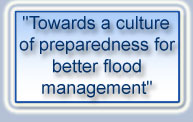| +91-612-2256999 | fmisc_bihar@yahoo.co.in | Site Map |
 |

|
 |
| Home | About Us | WRD | River basinMap | Contact Us | Rainfall Forecast |
|
The comprehensive FMIS would be developed in four stages. The first module was to be implemented before June 15, 2007, and operationalized during 2007 flood season, with focus on flood hazard characterization and emergency management and operational flood management information products, supplemented by improved flood forecast and inundation modeling, a flood website for public dissemination and access, updated flood control manuals, plans for upgrading hydrologic measurements and telemetry, and training. Providing and disseminating information tools will move sector agencies capacity from disaster response to improved disaster preparedness and to effectively support flood control and management in the focus area in North Bihar, from Burhi Gandak River in the west to Kosi River in the east, covering about 26,000 sq. km. The focus area covers the districts of East Champaran, Muzaffarpur, Samastipur, Begusarai Dharbanga, Sitamarhi,Sheohar, Madhubani, Supaul, Saharsa, and Khagaria. Three zonal Chief Engineers (of Samastipur, Birpur and Muzafarpur) exercise flood management functions in the focus area. The subsequent stages of FMIS development would cover substantially enhanced functions and products, supported by improved hydrologic observations and telemetry, more reliable and longer term rainfall forecasts, enhanced flood forecast and inundation prediction with better models, airborne Synthetic Aperture Radar (ASAR) surveys for real-time inundation information during floods, close-contour surveys of the flood plain, mapping floodplain geomorphology including micro-relief to understand and improve drainage, improved communication links and information flow, risk and vulnerability analysis, institutional and community outreach mechanisms, and real-time flood data dissemination. The fully upgraded FMIS would support preparation of master plan for flood control and drainage, irrigation improvement, and overall water sector development in Bihar State. Future expansion FMIS upgrading will address: 1) Expanded geographical coverage to include both north and south Bihar, 2) Expanded database and analysis functions to support more comprehensive early flood warning and drainage and flood control master plan preparation, and water management and irrigation improvement interventions, and 3) Improved and real-time flood data collection, analysis, and dissemination. Improved flood data collection may include Airborne Synthetic Aperture Radar (ASAR) for detailed survey of inundated area; on-board processing and electronic transmission to base station, for immediate dissemination of flood alerts may include messages customized for the cell phones in the target area, dissemination to community satellite radios, etc. Microwave sensors on board RADARSAT II satellite, and Indian Radar Imaging Satellite (RISAT) would provide cloud-free coverage. The latter satellite would also enable more timely acquisition of data than currently possible. Upgraded analysis functions would be developed for inundation from embankment breach, concurrent flooding in Main River and tributary and heavy rainfall coupled with river flood, supported by hydraulic and hydrodynamic models and close-contour survey of the flood plain, hitherto not available. Fresh flood plain surveys need to be conducted using ground surveys or using Airborne Laser Terrain Mapper (ALTR or LIDAR). Future Indian satellite missions would provide data of 1 m resolution and better, used to upgrade ground details currently planned from the Cartosat-1 satellite. The development framework for FMIS takes note of increasing data demands, improvements in data collection, processing and dissemination, and last-mile communication to users as in Fig below.
|
|

